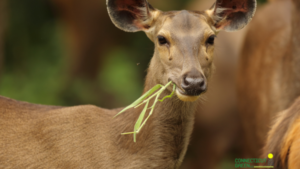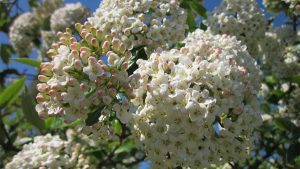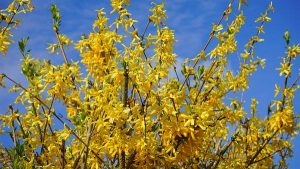Ornamental trees make our properties beautiful. Cherry and apple blossoms in the spring, the deep purple leaves of plum trees in the summer and fall, the delicate white bark of birch trees – these all add texture, color and interest to Connecticut gardens.
However, caring for ornamental trees can be challenging. With the beauty of these trees comes the risk of disease and insects. Certain varieties may be more susceptible than others, and it’s important to ensure you’re taking proper care of your trees if you want them to last through the years.
Here are some common ornamental trees in our area – and some signs of the diseases and infestations to look out for:
- Fruit trees like apple, crabapple, pear, cherry, and plum: These beautiful trees are popular because they’re generally easy to grow in Connecticut’s climate and soil. Their compact size and spring blossoms make them the shining stars of many gardens. However, fruit trees are vulnerable to rust diseases including cedar apple rust. Cedar apple rust commonly affects apple and crabapple trees. Like the pear trellis rust we referenced in our last blog post, cedar apple rust requires two hosts to infect a tree – in this case, typically a juniper or or eastern red cedar. (I should also note that since that last blog post, I’ve seen pear trellis rust on nearly every pear tree I’ve encountered. It’s spreading fast!)
Cedar apple rust begins as black spots on the tree, but eventually grows into raised black spots, and finally orange, finger-like tubes that grow out of the bottom of the leaf. These tubes emit spores, and can eventually affect the tree’s fruit. Other rusts are similar, but some, like quince rust, only affect fruit. While removing cedars and junipers from a 14 mile radius is the best (and least feasible) way to prevent rusts, fruit trees do respond well to preventative treatments.
- Dogwood: Dogwoods are an area favorite, and it’s easy to see why. With their delicate appearance and pink or white springtime blooms, they’re truly stunning trees! Dogwoods are hardy in Connecticut’s temperate climate, and they grow well in full sun to partial shade.
These beautiful trees may be infected by Anthracnose, also known as “Dogwood Blight.” This potentially devastating disease has been in our area since the 1970s. The fungus starts with small brown spots that go right through leaves, and over the course of years, can actually kill the tree. Caught early and treated, trees can be saved. They can also be treated preventatively with fungicide.
- Hawthorn: Hawthorns are related to apples, and grow an abundance of creamy white flowers in the spring. They are also especially attractive to songbirds, who love the berries these trees bear in fall and winter. Hawthorns grow from 15-30 feet tall, and grow their thorny branches in a wide canopy similar to apple trees. They love full sun and can tolerate most soil types.
Like apple trees, hawthorns are susceptible to rusts, as well as apple scab, fire blight and leaf spot. Some of these ailments are potentially fatal, so preventative spray is recommended for all hawthorns.
- Birch: The graceful white birch tree, with its pale and papery bark is the subject of many paintings. With its delicate leaves, it makes a dramatic addition to any garden. Birch trees prefer cooler, moist locations, and Connecticut marks one of the southern-most regions in which it grows.
Unfortunately, it’s this southern location that makes our birch trees more susceptible to bronze birch borers. These wood destroying beetles attack birches that have been weakened by soil compaction, drought and damage from other insects. Birch trees growing in the wild tend to be hardier and less vulnerable to borers, but those growing in gardens are generally more exposed to heat and dry conditions that weaken them. While the adult beetles tend to feed on the leaves of the tree, their larvae can cause extensive damage to the tree, including branch dieback.
The best way to prevent bronze birch borer damage is to ensure trees are properly watered and soil is well maintained. Preventative insecticide treatments are also very effective.
- Hemlock: The fragrant hemlock tree is among the most common – and most impressive – evergreens in North America. Hemlocks feature a perfect conical shape and small needles. In the wild, these trees can live up to 600 years!
However, the lengthy lifespan of the hemlock is at risk due to the infestation of woolly adelgids. Imported accidentally from Japan on infected nursery stock in the 1950s, these aphid-like insects are now a tremendous threat to hemlock trees. They feed on nutrient and water storage cells at the base of the needles, preventing the tree from receiving the nutrition it needs to survive. The key symptom of an infestation is the appearance of white “woolly” sacs along the base of the needles. Trees will shed their needles early, and significant dieback will appear in later stages of an infestation. Untreated, woolly adelgids will kill a tree within four to fifteen years.
Ornamental trees can bring beauty to your property for years – even generations. However, trees must be properly cared for in order to stay healthy and strong. At Connecticut Green, we have an extensive knowledge of the ornamental trees that thrive in our region. We understand the conditions they require to thrive, as well as the threats that face them in our environment. We can help your trees thrive with preventative treatments that will protect them from disease and infestation. If your trees are already showing signs of disease, we can treat them to restore their health.
Let us know if you’d like to add preventative treatments to your program. You can call or email us, or simply make a note of it on your 2018 contract renewal when it’s mailed to you in January.





